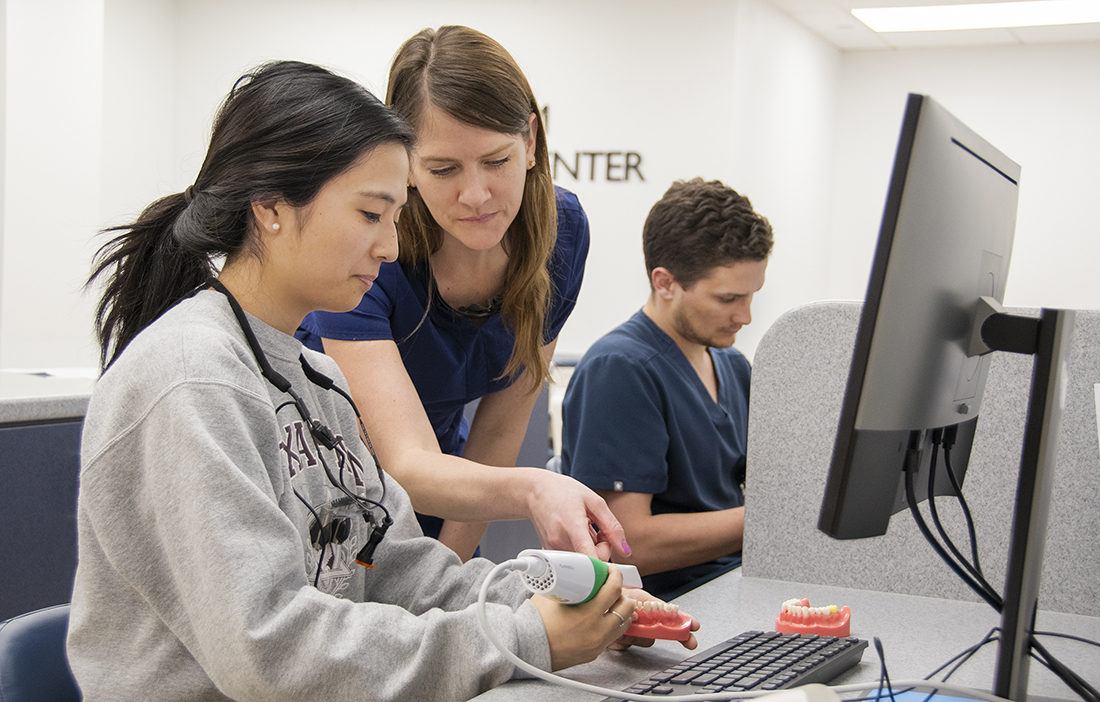CAD/CAM for D1s

For the first time, Texas A&M College of Dentistry’s entering dental students will be introduced to CAD/CAM dentistry in the first-year restorative dentistry course.
The CAD/CAM Education Center’s permanent preclinical laboratory, established in 2018, readily accommodates this change. In 2015, the technology was incorporated for second-year dental students, but before that CAD/CAM applications existed only in the curriculum’s D4 year. CAD/CAM rotations will now begin in the D1 spring semester.
“It is an aim in dental education to incorporate CAD/CAM and digital dentistry into all levels of the curriculum,” says Dr. Amanda Buie ’12, clinical assistant professor in the department of restorative sciences, whose leadership with Dr. Janna Burnett ’09, fosters the technology’s inclusion at the preclinical level.
“It was the dean’s vision and ours to help fulfill that, bringing CAD/CAM technology earlier in the curriculum,” Buie says. “Before the students are exposed to the technology clinically, we want to make sure they have had adequate training and experiences preclinically.”
In the D1 restorative dentistry course, students will gain experience scanning and designing crowns as well as assessing their wax-ups through Planmeca’s software program called Compare. In the D2 year, students scan, design and mill a crown using the Planmeca mill shared with the clinical courses. They will continue developing their skills through the D2, D3 and D4 years.
“The Compare educational software gives the students the ability to three-dimensionally view and assess their wax-up or crown preparation, which improves their knowledge and skills,” Buie says.
She explains the Planmeca system was chosen because of its capability to produce a color-coded surface map, which shows students where their wax-up or crown preparation may be over reduced, under reduced or within tolerance range compared to a master tooth or preparation. The technology also produces numerical averages for crown preparation parameters such as margin width, total occlusal convergence, and axial wall height. The software can show in red where students have undercuts on crown preparations.
According to “Implementation of New Technologies in U.S. Dental School Curricula,” published in the Journal of Dental Education, 55% of U.S. dental schools surveyed offer preclinical CAD/CAM laboratory education as part of their curriculum. The 2014 research by Brownstein, Murad and Hunt analyzes how all aspects of dental technology are being integrated by both public and private dental colleges.
Funding for the CAD/CAM Education Center was provided through $40,000 from the James S. Cole Professorship, which is held at Baylor Oral Health Foundation; an additional $140,000 from the foundation; and two gifts totaling $118,000 from The Association of Former Students of Texas A&M. The association’s initial gift was used to purchase the first three preclinical E4D units in 2015. This year, an additional $200,000 from the foundation will aid program expansion.
The education center now has 10 permanent work stations in a designated room adjacent to the simulation laboratory. Before, the units were carted in and out of a storage closet and only set up at specific times during the D2 fixed prosthodontics laboratory course. D2 students can now access the technology in its secured lab during lab hours or after hours with badge access, says Buie, who oversees the center. Next year, the D1 students will have badge access to the lab as well. The lab may be used by any faculty member or student; they will simply need to email Dr. Buie to get badge access when needed.
The lab is open 8 a.m. to 6 p.m. weekdays. Cardholders, however, are allowed early bird hours two hours before the lab officially opens during the week. On the weekends, they have access from 7 a.m. to midnight.
“Having badge access to the CAD/CAM Education Center after hours provides an advantage to the students. They can enter the lab on their own time to scan and assess their crown preparations, or work on D2 fixed prosth CAD/CAM lab assignments when the faculty are not there. They can receive instant, objective feedback with the technology,” Burnett says. Next year, this privilege will be expanded to D1s.
There’s only one more wish-list item that would make the lab complete: a mill for milling crowns. This would provide an opportunity to incorporate more CAD/CAM projects and expand digital applications in the preclinical courses.